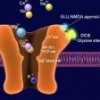D-Serine is a coagonist at the NMDA receptor and is thought to bind to the glycine binding spot, albiet with higher potency. In concert with glutamate and in the absence of magnesium, D-Serine activates the NMDA receptor and promotes calcium entry. The end result is increased transcription/translation of various gene products. In the hippocampus, activating this system promotes long term potentiation (LTP) via BDNF & trkB upregulation.
The racetams allosterically activate this system and would synergize well with D-Serine. Specifically, Aniracetam (or the ampakines) would promote magnesium displacement via AMPA activation & cellular depolarization, and Piracetam would synergize more locally on the NMDA receptor itself.
The product: https://www.prototyp...?ProductCode=DS
Some interesting studies:
D-serine regulation: a possible therapeutic approach for central nervous diseases and chronic pain.
D-Serine, an endogenous modulator of NMDA receptors has been shown to play a vital role in many neuropsychiatric functions such as learning, memory, nociception and implicated in pathological conditions like schizophrenia and Alzheimer's disease. We propose possible therapeutic approaches for some CNS diseases and chronic pain, targeting the D-serine levels by manipulating its uptake, biosynthesis and metabolism.
http://www.ncbi.nlm....pubmed/19519506
D-Serine: a key to synaptic plasticity?
Two discoveries have put D-serine in the spotlight of neuroscience. First, D-serine was detected in brain tissue at high levels. Second, it was found to act on the N-methyl-D-aspartate receptor (NMDAR). This receptor is central to use-dependent synaptic plasticity, the cellular process which is widely believed to underlie learning. The ensuing quest for the mechanisms of D-serine synthesis, release and clearance, as well as for its physiological significance has provided a wealth of experimental evidence implicating D-serine in synaptic plasticity. However some key questions remain unanswered. Which cells release D-serine and upon what stimuli? Is D-serine supply dynamically regulated? What is the fate of released D-serine? Answering these questions appears to be an essential step in our understanding of how NMDARs trigger synaptic plasticity and learning. This review will highlight some recent advances and avenues of enquiry in dynamic D-serine signaling in the mammalian brain with emphasis on neurophysiology.
http://www.ncbi.nlm....pubmed/22266400
Effects of low-dose D-serine on recognition and working memory in mice.
CONCLUSIONS: Our results show that treatment with D -serine can improve performance in tasks related to recognition learning and working memory, suggesting that this agent can be useful for the treatment of disorders involving declines in these cognitive domains.
http://www.ncbi.nlm....pubmed/21556803
In depth explanation of hippocampal glutaminergic signaling: http://hightowerphar...s-volume-1.html



















































